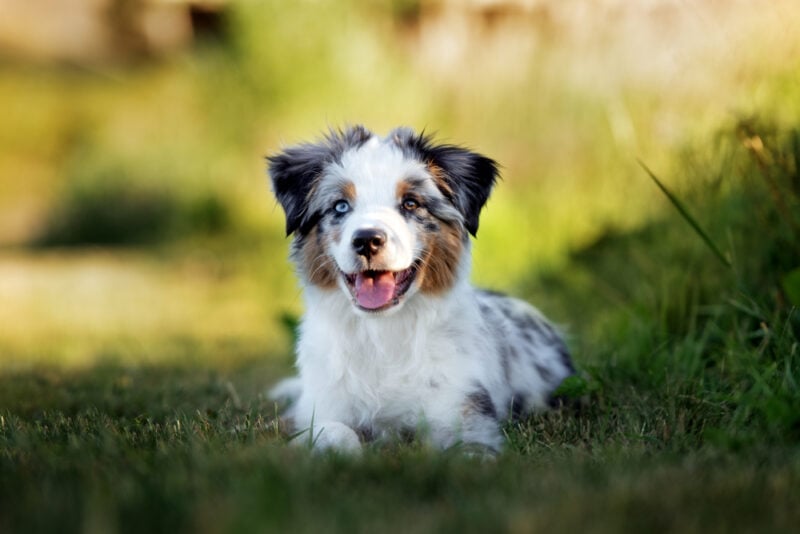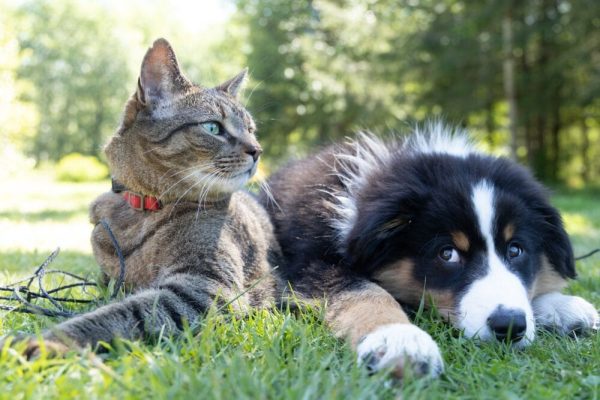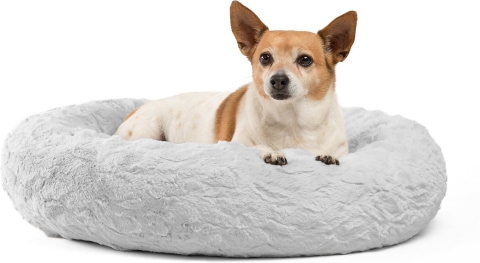In this article
View 3 More +Australian Shepherds and German Shepherds may both have “shepherd” in the name, but they couldn’t look more different. The large, dark-colored German Shepherd has an intimidating appearance and reputation, while Aussies are smaller and more colorful. But these breeds have a great deal in common, even if they don’t look like it.
If you’re in the market for a Shepherd dog, both of these breeds bring a lot to the table. Here are some of the similarities and differences between the two breeds.

Visual Differences

At a Glance
- Average height (adult): up to 23 inches
- Average weight (adult): 40–65 lbs
- Lifespan: 11–14 years
- Exercise: 2+ hours a day
- Grooming needs: Moderate
- Family-friendly: Yes
- Other pet-friendly: Yes
- Trainability: Intelligent and trainable
- Average height (adult): up to 26 inches
- Average weight (adult): 55–90 lbs
- Lifespan: 9–12 years
- Exercise: 2+ hours a day
- Grooming needs: Moderate
- Family-friendly: Yes
- Other pet-friendly: Yes
- Trainability: Intelligent and trainable

Australian Shepherd Overview

Appearance
The Australian Shepherd is a mid-sized dog that can weigh anywhere from 40–60 pounds. This breed can measure up to 23 inches at the shoulder. It has a soft, long coat that can be almost any color. Australian Shepherds have slightly floppy ears and often have mismatched eye colors. Australian Shepherds can live anywhere from 11 –14 years.
Trainability
Australian Shepherds are among the most trainable dog breeds. Their breeding as a herding dog has primed them to work closely with their owners, perform complex tasks, and follow instructions. They are generally eager to please. However, it’s important to have a good dynamic between pet and owner, as poorly trained Australian Shepherds can become destructive, irritable, and reactive. Australian Shepherds are often used in working situations where their smaller size compared to other highly trainable breeds is an advantage. One of the most common uses for Australian Shepherds is in avalanche or wilderness rescue situations, because their handlers can carry them over difficult terrain.
Personality and Behavior
Australian Shepherds’ personality is defined by their energy, intelligence, and loyalty. They are driven and hard-working when set to a task, but if you keep an Australian Shepherd as a pet, you should expect to spend a lot of time playing with them. When left alone for too long or kept in too small of a space, these dogs can quickly burn through their energy by becoming destructive. They are very loyal to their owners and can become protective, but they are generally fairly easygoing dogs who can be friendly and outgoing. Australian Shepherds can be a great choice for families with children or other pets as long as they have proper socialization.

Care Needs
Australian Shepherds and German Shepherds have similar care needs. Australian Shepherds need several hours of exercise and socialization each day. Australian Shepherds need space to run and explore, so they aren’t the best suited for apartment life. Their background as working dogs means that they prefer to be around their owners for most of the day, and can struggle if left home alone for hours at a time on a daily basis. Australian Shepherds have long coats that require regular brushing. They have a healthy appetite and generally require high-protein, high-quality food.
Suitable For:
Australian Shepherds are best suited for individuals and families who have time and space to care for a high energy dog. They will be happiest with owners who spend most of their day at home or can take a dog with them when away from home. Experienced owners who are used to the time and care that an Australian Shepherd requires and have the time to train them regularly will find this a rewarding breed to have, but this dog breed isn’t right for everyone.

German Shepherd Overview

Appearance
The German Shepherd is much larger than the Australian Shepherd, weighing in at around 50–90 pounds. Although it’s generally heavier, it isn’t that much taller, reaching up to 22 inches in height at the shoulder. German Shepherds have short or medium length coats that can come in a variety of colors.
However, the most popular color combination for German Shepherds is black and tan. German Shepherds have pointed, upright ears and long, fluffy tails. They also tend to have longer faces than Australian Shepherds. Because they are a larger breed, it isn’t surprising that they have a slightly shorter lifespan—about 9–12 years.
Trainability
Like Australian Shepherds, German Shepherds are highly trainable. It is crucial to build a relationship of trust with a German Shepherd, as these dogs can be stubborn and fight for dominance without that relationship. Once a good relationship is established, these dogs are among the most intelligent and obedient breeds out there. German Shepherds are able to stay “on the job” all day long, making them a common choice for police and military units, guide dogs, and emergency response dogs.
Personality and Behavior
German Shepherds have similar temperaments to Australian Shepherds in many ways, but with a few key differences. These dogs have a great deal of energy as well. Their energy can be put to good use in play, exercise, and work, but it can also turn towards destructive behavior if their exercise needs aren’t met. These dogs can do well with families and other pets as long as they have good socialization and they are receiving the stimulation they need and deserve.
German Shepherds tend to be slightly more reserved and serious than Australian Shepherds, but personalities vary from dog to dog. German Shepherds can be very protective of their homes and owners. This can be great if you want a dog that will be a good guard dog, but German Shepherds are more likely to need training in order to interact with strangers.

Care Needs
German Shepherds have high care needs. They require a lot of time and energy to keep them stimulated, and you should expect to spend several hours a day with them. They don’t generally do well in small apartments as they need space to run and exercise. They also need significant social interaction, and can struggle with being left behind if you need to leave them each day for work. German Shepherds are larger than Australian Shepherds, which makes their food needs more intensive. Their short coats will require daily brushing during the spring and fall, but they may be fairly low maintenance the rest of the year.
Suitable For:
German Shepherds also are happiest with owners who have the time and space to meet their energy needs. Like Australian Shepherds, they can struggle with being home alone and do best with experienced owners. They can be suitable for individuals or families and can get on well with other pets. These dogs can be great guard dogs or working dogs with proper training. Although the investment required to take care of a German Shepherd is high, the bond these dogs form with their owners is a big reward.

German Shepherd/Australian Shepherd Mixes
If you still can’t decide between an Australian Shepherd or a German Shepherd, another option is to buy an Aussie/German Shepherd mix breed. This is a relatively common mix and the dog will have traits from both parent breeds. Like the parent breeds, this will be a high-energy dog that needs an investment in time and energy. Australian Shepherd/German Shepherd Mixes are generally midway between the two breeds in size and can have a range of physical features inherited from either parent.

Which Breed Is Right For You?

Australian Shepherds and German Shepherds aren’t for everyone, but most owners who would do well with one will also do well with the other. Whether you are looking for a working dog or a pet, both breeds will be trainable, intelligent, active companions. However, there are a few small differences to consider.
The difference in size can have a big impact on your relationship with your dog. Most adults can pick up or physically control an Australian Shepherd, while the larger German Shepherds are too big for many to handle without relying on good training. German Shepherds also need more food and space to run. German Shepherds also have a slightly more reserved and serious personality, while Australian Shepherds can be a little more relaxed and easygoing. Whichever breed you choose, you’re sure to have an unparalleled bond between you and your dog.


















